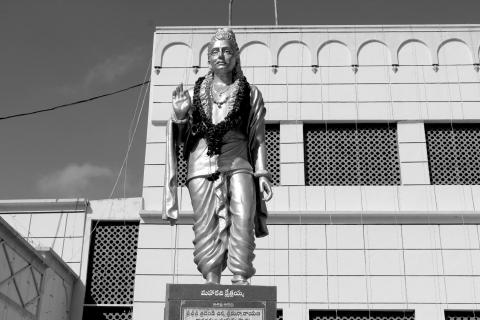November 2021

Sat-karma itself is dharma. It is of three kinds:
Laukika (pertaining to the world)
Vaidika (pertaining to the Vedas)
Pāramārthika (pertaining to the ultimate truth)
Laukika dharma is what we commonly follow in the world – bhūtadayā (compassion towards all creatures), sadācāra (virtuous conduct), satya(truth), ahiṃsā(nonviolence), śauca(purity), kṣamā(mercy), dīnavātsalya (tenderness towards the wretched), para-hita-cintana (thinking of...

Maharṣi Vālmīki
The story narrated in the first four cantos of the Rāmāyaṇa is of great significance to the central concepts of the creative process: poet, poetry and connoisseur. In the opening canto, Ādikavi Vālmīki questions Maharṣi Nārada about the ideal human being, the model protagonist. This simple enquiry has far-reaching undertones. It has supplied flavour to the dry and rather unintelligible aesthetic dictum that expects the hero of a...

When Devasomā interrupts to say this isn’t the way of buddhists or jains (अर्हन्त can apply to both), Satyasoma scolds them saying that they are fools who contradict their own stand by saying pain leads to pleasure while thinking that the nature of the effect is the same as that of the cause. During this and even later, it is evident that Satyasoma even though drunk and unsteady still has a sharp intellect which hasn’t been affected by the...

Candrasvāmin met Siṃhadaṃṣṭra, a śabara chief and asked him for a water source nearby, he called his men and said, ‘Show him water!’ They took him to their village and tied him up. He understood he had been deceived. Thinking about his children’s future if he is killed and offered as a bali he started worshipping Sūrya. A voice from the sky told him, ‘Candrasvāmin, you won’t be killed; you’ll reunite with your children!’ The children meanwhile...

Languages and meters
While nothing of value is added by mentioning what has been discussed by both Dr N P Unni and Dr S Ramaratnam, just for the sake of completion, here is the list of meters and languages used. Even in a small work the author has shown versatility in usage of languages and meters which can be gathered by a cursory glance of the lists below.
Metres: Anuṣṭup, Āryā, Indravajra, Rucirā, Mālinī, Vaṃśasthā, Vasantatilakā,...

High-water Mark of Critical Examination
The forewords that Sarma wrote to some of the books in Telugu and Kannada have turned out to offer an excellent, holistic view of the entire subject rather than being mere introductory words of formality that appear at the beginning of the book. His forewords to books have been published as a separate volume.
It was characteristic of Sarma to make an in-depth examination of the smallest of the small...

Art appreciation begins with learned connoisseurs. Gaining breadth and vision with time, it develops into a well-structured system of aesthetics. Poets and artists often find it hard to explain the aspects of appeal inherent in the form and substance of their compositions. They have neither the bent of mind nor the competence to subject their work’s appeal to a logical analysis. Only a handful of artists can tell us what goes into the making of...

Powerhouse of Genius
Sarma received awards for many of his Sanskrit and Telugu works. Śrī Mahīśūra-rājyābhyudayādarśaḥ, his classical poetry composition about the progress of Mysore, was awarded the first prize. Those verses are delightful to hear. In his eyes, Karnataka was a land of enjoyment in all seasons[1] and this kingdom of Mysore could only be enjoyed by fortunate people.[2]
This was his description of the transactions at the Mysore...


